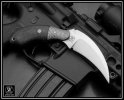Hi Joe, it's not the Karate Kid but
Merantau!
Selamat berkenalan Sharpend.
I'm just an ordinary knife collector.
Being a Malay I'm kind of exposed to some info of the edged tools in South east Asia especially in Malay Archipelago.
So here I'm just trying the best to give my two cents about it.
It's what we called as
Kuku Rimau.
Actually it's the smallest one in the Kerambit family of blades.
And traditionally
Kuku Rimau doesn has a finger ring at the end of the handle.
Let's make it simple, IMVHO it's easier to say that all those Kerambit and the family originated from Malay Archipelago.
Philippines, Southern Thai, Malaysia, Singapore and Indonesia are the modern names for all the newly drawn borders after the Malay Archipelago were being colonized, devided and separated by the colonialists and then gaining independence one after another (i.e. please, I'm not touching about politic but history).
Yes, AFAIK all those are under one big
Kerambit family.
Of course those are different edged tools which are categorized under
Arit/Sabit family.
You're correct, pal!
The
Kerambit family consists of the following categories:
1.
Karambit/Kerambit/Korambit/Krambit/Kurambik is the medium size version in the
Kerambit family and it normally has a ring at the end of the handle.
2.
Kuku Rimau/Kuku Macan is smallest version in the Kerambit family and traditionally it doesn't has any ring at the end of the handle. Sometimes it has a pronounced hilt/spike at the end of the handle.
3.
Lawi Ayam/Rambai Ayam is the second largest version in the
Kerambit family and traditionally it doesn't has any ring at the end of the handle. And it has a slight wave at the blade tip.
4.
Beladau is the largest version of the Kerambit family. Sometimes it is less curvy. Anyhow traditionally it has a thumb grove at the end of the handle.
IMVHO Claudio's version and Kyle's version are the modern interpretation of a
Lawi Ayam/Beladau.
Again IMVHO Ryan's version is a modern interpretation of a
Kuku Rimau/Kuku Macan.
While Chuck's version is a folder interpretation of a
Karambit.
And all those beautiful pieces are still categorized in the
Kerambit family.
Claudio AFAIK is a very nice knifemaker and he's very friendly with his customer!
Sharpend, why not you just PM Claudio or send him an email.
Maybe you can discuss with him the actual piece which best suit your taste and requirements

Hope my two cents helps a little!
mohd





















